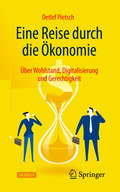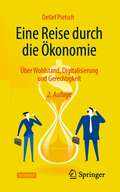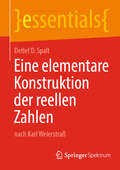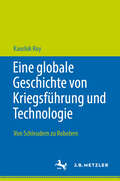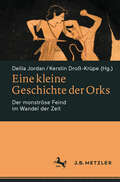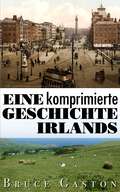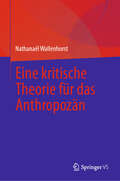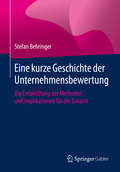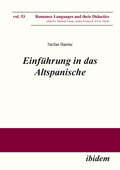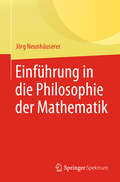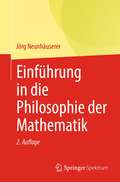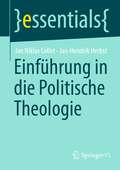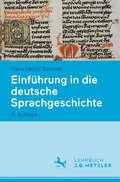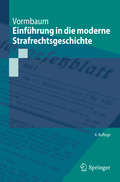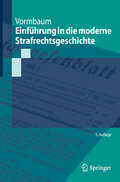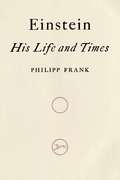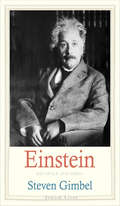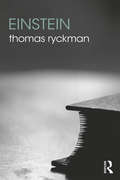- Table View
- List View
Eine Naturforscherin zwischen Fake, Fakt und Fiktion: Multidisziplinäre Perspektiven zu Werk und Rezeption von Amalie Dietrich (Frauen in Philosophie und Wissenschaft. Women Philosophers and Scientists)
by Wiebke Waburg Nicole HoffmannWas Amalie Dietrich, eine naturwissenschaftliche Sammlerin des 19. Jahrhunderts, für eine multidisziplinäre Auseinandersetzung heute so interessant macht, ist die besondere Quellenlage: Neben den von ihr präparierten Museumsstücken liegt eine Vielzahl an Publikationen über sie vor, in denen sie und ihr Werk höchst unterschiedlich thematisiert werden: u.a. als frühe Naturforscherin, alleinerziehende Mutter, feministische Pionierin oder auch als koloniale Grabschänderin. Die Beiträge des Sammelbands loten jeweils einen Aspekt dieses Facettenreichtums aus, um dem widersprüchlichen Bild auf die Spur zu kommen.Die HerausgebendenProf. Dr. Nicole Hoffmann ist Pädagogin und arbeitet in den Bereichen Weiterbildung und Genderforschung an der Universität in Koblenz.Prof. Dr. Wiebke Waburg lehrt Pädagogik mit dem Schwerpunkt Migration und Heterogenität an der Universität in Koblenz.
Eine Reise durch die Ökonomie: Über Wohlstand, Digitalisierung und Gerechtigkeit
by Detlef PietschWer die Geschichte der Wirtschaft nicht kennt, kann auch nicht kompetent über die Zukunft der Wirtschaft nachdenken. Dieses Buch bietet einen Einstieg in die Wirtschaftsgeschichte für alle, die nach mehr als nur trockener Theorie suchen. Der Autor führt Sie auf eine Reise durch die Ökonomie von den Anfängen in der Steinzeit bis hin zur Digitalisierung in der Neuzeit. Neben dem Wesen und Grundprinzipien der Ökonomie werden vor allem auch große Denker wie Aquin, Keynes und Erhard vorgestellt. Während es den antiken Philosophen wie Platon und Aristoteles vor allem um die ethische Dimension des Wirtschaftens ging, dachte der erste neuzeitliche Ökonom und Moralphilosoph Adam Smith beispielweise darüber nach, wie Nationen zu Wohlstand gelangen können. Heute hingegen – in einer Zeit, in der der Kapitalismus zunehmend unter Beschuss gerät – stellt sich eher die Frage, wie (in Zeiten der Digitalisierung) der Wohlstand bei allen ankommen kann. Das Buch greift demnach nicht nur die ökonomischen Konzepte der Vergangenheit und der Gegenwart auf, sondern wirft auch einen spannenden Blick auf die Zukunft. Fragen der sozialen Gerechtigkeit werden genauso diskutiert wie die Themen Digitalisierung, Globalisierung und Ökologie.
Eine Reise durch die Ökonomie: Über Wohlstand, Digitalisierung und Gerechtigkeit
by Detlef PietschWer die Geschichte der Wirtschaft nicht kennt, kann auch nicht kompetent über die Zukunft der Wirtschaft nachdenken. Dieses Buch bietet einen Einstieg in die Wirtschaftsgeschichte für alle, die nach mehr als nur trockener Theorie suchen. Der Autor führt Sie auf eine Reise durch die Ökonomie von den Anfängen in der Steinzeit bis hin zur Digitalisierung in der Neuzeit. Neben dem Wesen und Grundprinzipien der Ökonomie werden vor allem auch große Denker wie Aquin, Keynes und Erhard vorgestellt. Während es den antiken Philosophen wie Platon und Aristoteles vor allem um die ethische Dimension des Wirtschaftens ging, dachte der erste neuzeitliche Ökonom und Moralphilosoph Adam Smith beispielweise darüber nach, wie Nationen zu Wohlstand gelangen können. Heute hingegen – in einer Zeit, in der der Kapitalismus zunehmend unter Beschuss gerät – stellt sich eher die Frage, wie (in Zeiten der Digitalisierung) der Wohlstand bei allen ankommen kann. Das Buch greift demnach nicht nur die ökonomischen Konzepte der Vergangenheit und der Gegenwart auf, sondern wirft auch einen spannenden Blick auf die Zukunft. Fragen der sozialen Gerechtigkeit werden genauso diskutiert wie die Themen Digitalisierung, Globalisierung und Ökologie.Die zweite Auflage wurde aufgrund der aktuellen globalen Ereignisse um ein Kapitel zur „Ökonomie in unsicheren Zeiten“ ergänzt, welches sich u.a. mit den ökonomischen Folgen der Corona-Pandemie und des Krieges in der Ukraine beschäftigt.
Eine Rose für einen Schwerenöter (Ein Walzer für einen Schwerenöter #6)
by Collette Cameron®Was soll ein zukünftiger Herzog tun, wenn die unpassendste Frau sein Herz erobert? Eden hatte stets den leisesten Hauch von Skandal in ihrem Leben unterbunden. Mit den Marquis von Sterling zusammenzustoßen und dabei die Eier auf seine Stiefel fallen zu lassen, war nicht die dümmste Sache, die Eden Haverden jemals gemacht hatte. Unklugerweise einzuwilligen, den charmanten Schwerenöter nach Hause zu fahren, da sein Pferd lahmte, war sicherlich auch nicht die dümmste Sache. Aber widerstrebend Chesters Einladung anzunehmen, die Nacht auf seinem Familienanwesen zu verbringen, nachdem sie fast ertrunken wäre? Ja, das war sicherlich eine unüberlegte Entscheidung gewesen, die den gesellschaftlichen Ruin versprach. Also, warum hatte sie nicht auf ihren gesunden Menschenverstand gehört? Die Sünden der DeCourcys hatten Chester sein ganzes Leben lang verfolgt. Entschlossen, eine neue Ära im angeschlagenen Herzogtum einzuläuten, sind alle Handlungen und Entscheidungen Manchesters geleitet von Sorgfalt und Disziplin. Ein vernünftiger, zielstrebiger Mann sollte sich nicht von der vollkommen unpassenden Eden Haverden ablenken lassen. Nicht nur, dass sie der uneheliche Sprössling vom Erzfeind seines Vater ist, sie ist auch noch die Schwester des Mannes, der seinen Bruder getötet hat. Warum also kann er der starken Verbindung zwischen ihnen nicht widerstehen? Kann Chester Eden davon überzeugen, die Fehde zwischen ihren Familien außer acht zu lassen und ihm ihr Herz anzuvertrauen?
Eine elementare Konstruktion der reellen Zahlen: nach Karl Weierstraß (essentials)
by Detlef D. SpaltDieses essential stellt in kondensierter Form eine Neuinterpretation der Weierstraß'schen Konstruktion der reellen Zahlen vor: Ein vergleichsweise neuer Quellenfund lässt darauf schließen, dass der Weierstraß’sche Zahlbegriff bereits auf Mengenbegriffen basierte und somit sehr viel elementarer ist, als bislang angenommen wurde.Die beiden bislang bekanntesten Alternativdefinitionen der reellen Zahlen – mittels rationaler Folgen und Konvergenz (Cantor) bzw. als Segmente (Dedekind) – werden hier ebenfalls kurz erläutert und mit der Weierstraß’schen Konstruktion verglichen.Eine ausführliche Darstellung anhand der Originalquellen findet sich in Spalt, Die Grundlegung der Analysis durch Karl Weierstraß (Springer Spektrum, 2022).
Eine globale Geschichte von Kriegsführung und Technologie: Von Schleudern zu Robotern
by Kaushik RoyDieses Buch behandelt die globale Geschichte von Technologie, Kriegsführung und Staatenbildung vom Steinzeitalter bis zum Informationszeitalter. Unter Verwendung einer Kombination von Top-Down- und Bottom-Up-Methoden untersucht es sowohl zwischenstaatliche als auch innerstaatliche Konflikte mit einem Schwerpunkt auf eurasischer Technologie und Kriegsführung. Es zeigt, wie menschliches Handeln und strukturelle Faktoren miteinander verflochten sind und ein komplexes Geflecht von Technologie und Kriegsführung schaffen. Es erforscht auch das Zusammenspiel zwischen technologischen und nicht-technologischen Faktoren, um die Entwicklung der Kriegsführung von ihren Anfängen bis heute zu veranschaulichen, und argumentiert, dass die Interaktionen zwischen zivilen und militärischen Sektoren den Einsatz von Technologie in der Kriegsführung geprägt haben. Aufgrund ihres Umfangs und ihrer Tiefe ist es eine wertvolle Ressource für Forscher in Bereichen wie Weltgeschichte, Geschichte von Wissenschaft und Technologie, Geschichte von Kriegsführung und Imperialismus sowie Internationale Beziehungen.
Eine kleine Geschichte der Orks: Der monströse Feind im Wandel der Zeit
by Kerstin Droß-Krüpe Delila JordanEin Tötungsverbot gehört zu den Grundregeln aller zivilisierten Gesellschaften - im Krieg ist dieses Verbot aber plötzlich außer Kraft gesetzt. Dies führt zu sozialen, religiösen und ideologischen Problemen, die häufig durch die Dehumanisierung der Gegner gelöst werden. Der Feind wird zum Monster. In der Populärkultur übernehmen heute meist Orks die Rolle des monströsen Feindes. Das moderne Bild der Orks wurde zwar von J.R.R. Tolkien geprägt, er konnte jedoch auf eine lange Tradition der Darstellung des Feindes als Monster zurückgreifen, die im vorliegenden Band analysiert wird.
Eine komprimierte Geschichte Irlands
by Bruce GastonDieses E-Book enthält eine kurze Geschichte Irlands von der Antike bis ins 21. Jahrhundert und richtet sich an alle, die sich einen schnellen Überblick über das Thema verschaffen oder ihre Wissenslücken schließen möchten. Das knapp aber vollständig gehaltene Buch kann innerhalb weniger Sitzungen gelesen werden. Damit eignet es sich für alle, die nur eine Zusammenfassung der wichtigsten Fakten benötigen und nicht die Zeit oder das Durchhaltevermögen aufbringen möchten, wissenschaftliche Abhandlungen zu wälzen. Eine komprimierte Geschichte Irlands enthält auch Kurzbiographien von Schlüsselfiguren der irischen Geschichte, eine umfassende Zeitleiste von der keltischen Zeit bis 2020 und Vorschläge für weitergehende Lektüre zur Geschichte Irlands.
Eine kritische Theorie für das Anthropozän
by Nathanaël WallenhorstDieser Band, der in biogeophysikalischen Studien verwurzelt ist, befasst sich mit Konzepten des politischen Handelns im Anthropozän und der Spannung zwischen dem Wunsch, das prometheische Projekt der Moderne zu vollenden, und einem post-prometheischen Ansatz. Diese Arbeit untersucht die Idee einer anthropologischen Mutation der politischen Konsolidierung von einem "postprometheanischen Miteinander" zur Schaffung der Fähigkeit zum gemeinsamen Handeln. Das von Hannah Arendt entwickelte politische Denken über die conditio humana ist hier als Ressource für das Denken über die Menschheit im Sinne des menschlichen Abenteuers wichtig. Dieses hat drei Dimensionen: Hybris, Welt und Koexistenz, die sich jeweils auf die Logik des Profits des homo oeconomicus, die Logik der Verantwortung des homo collectivus und die Logik der Gastfreundschaft des homo religatus beziehen.. Die in diesem Buch skizzierte intellektuelle und politische Haltung ist eine Erweiterungder kritischen Theorie: Das Werk übt auch Kritik an dem, was in unserer Beziehung zur Welt ein Problem darstellt, und schlägt vor, wie es überwunden werden kann, wobei das Endziel die soziale Transformation ist. Der Autor schlägt einen Aufstand und eine anthropologische Konsolidierung der Politik vor, die auf der Wiederbelebung beruht, die durch das Teilen einer Konvivialität sowohl zwischen den Menschen als auch mit dem Nicht-Menschlichen hervorgerufen wird. Die Identifizierung der Konvivialität als ein Bildungsparadigma, um das Anthropozän zu überleben, gibt uns trotz dieses Erbes des Anthropozäns den dringend benötigten Grund zur Hoffnung. Neben dem Arendt'schen Denken stützt sich diese kritische Theorie für das Anthropozän auf das politische Denken mehrerer zeitgenössischer Autoren, darunter Maurice Bellet, Hartmut Rosa, Andreas Weber, Dominique Bourg und Christian Arnsperger. Dieser Band ist für Forscher des Anthropozäns von Interesse.
Eine kurze Geschichte der Genetik
by Rolf KnippersDer Rückblick auf 100 Jahre Genetik ergibt eine faszinierende Geschichte, die in diesem Buch leicht und gut verständlich erzählt wird. Genforschung, Genetik in Landwirtschaft und Medizin sind viel verwendete Wörter in öffentlichen Debatten. Dabei ist nicht jedem bekannt, dass Genetik eine junge Wissenschaft ist, gerade einmal hundert Jahre alt. Der zentrale Begriff des Gens hat ständig neue Bedeutungen erhalten, oft befrachtet mit Ungenauigkeiten, wenn man an die Irrwege der Eugenik und an die Diskussion um die Vererbbarkeit von Intelligenz denkt.
Eine kurze Geschichte der Genetik
by Rolf KnippersGenforschung, DNA, Gene und Genome, Genetik in Landwirtschaft und Medizin, in Erziehung und Psychologie - diese Begriffe sind nicht nur in der Fachwelt, sondern auch in den Feuilletons der Zeitungen, in Funk, Fernsehen und öffentlichen Debatten des 21. Jahrhunderts allgegenwärtig.Dabei ist durchaus nicht jedem bekannt oder bewusst, dass die Genetik eine relativ junge Wissenschaft ist und erst Anfang des vorigen Jahrhunderts Gestalt annahm. Der zentrale Begriff des Gens erhielt dabei im Laufe der Jahrzehnte bis heute ständig neue und andere Bedeutungen, oft befrachtet mit allerlei Unklarheiten und Ungenauigkeiten, ja, mit Abstrusitäten, wenn man an die Irrwege der Eugenik und an die Diskussionen um die Vererbbarkeit von Intelligenz denkt. Die Gentechnik hat weltweit zahlreiche Debatten ausgelöst, die bis heute anhalten; neue Kämpfe werden ausgefochten über Gene in Nahrungsmitteln, Gene als Rohstoffe von Wachstumsindustrien und die Möglichkeiten der immer gezielteren Eingriffe in das Erbgut bis hin zur synthetischen Biologie. Die Gene und die Genetik stehen heute genauso wie in den Jahrzehnten zuvor im Blickpunkt der Öffentlichkeit.Der Rückblick auf gut hundert Jahre Genetik enthüllt eine faszinierende Geschichte. Diese Geschichte wird im vorliegenden Buch leicht, lebhaft und gut verständlich erzählt und in der 2. Auflage bis in die jüngste Vergangenheit fortgeschrieben. Das Werk richtet sich an Leser, die an der Entwicklung von Ideen interessiert sind, aber besonders an solche, die wissen wollen, wie und warum Gene und Genetik zu Schlüsselworten des Jahrhunderts wurden.
Eine kurze Geschichte der Unternehmensbewertung: Die Entwicklung der Methoden und Implikationen für die Zukunft
by Stefan BehringerDas Werk bietet einen Überblick der Entwicklungsgeschichte der Unternehmensbewertung. In der betriebswirtschaftlichen Literatur wird sie häufig als „Königsdisziplin“ bezeichnet, da sich im Unternehmenswert alle betrieblichen Funktionen wiederspiegeln. Dies führt zu einer komplexen Fragestellung, die sich nur mit komplexen Methoden lösen lässt. Neben dieser anspruchsvollen theoretischen Basis ergibt sich in der Praxis ein erheblicher Bedarf an tatsächlich durchgeführten Unternehmensbewertungen. Diese sind bei Käufen und Verkäufen von Unternehmen notwendig, aber auch bei rechtlichen Auseinandersetzungen, z. B. bei Erbschaften. Außerdem werden Unternehmenswerte für die Bestimmung von Bemessungsgrundlagen zur Besteuerung der Substanz benötigt. Trotz der Komplexität der Aufgabe sind hierbei feste Regeln notwendig, die eine willkürliche Ermittlung von Unternehmenswerten vermeiden.Aufgrund der besonderen Bedeutung der Unternehmensbewertung hat sich auch die betriebswirtschaftliche Forschung intensiv mit den zugrundeliegenden Fragestellungen befasst und immer wieder neue Methoden entwickelt. Einerseits wurden Methoden aus der Praxis übernommen, andererseits haben sich praktische und theoretische Entwicklungen voneinander entfernt. Das vorliegende Buch stellt diese wesentlichen Entwicklungen dar und bezieht jeweils den aktuellen Stand der Diskussion ein. Das Buch richtet sich an Leser, die sich in ihrer beruflichen Praxis mit der Unternehmensbewertung befassen, sowie an fortgeschrittene Studierende und Doktoranden.
Einführung in das Altspanische
by Stefan BarmeThis introduction to Medieval Spanish, or Old Spanish, closes a long-standing gap in the literature. Focusing on the internal history of the Spanish language, it traces its phonetic, grammatical, and lexical development from classical and vulgar Latin to Medieval Spanish. The characteristics of the Old Spanish language are also illustrated through a presentation and commentary of suitable text excerpts that represent its different stages of development.
Einführung in das Altspanische (Romance Languages and Their Didactics #53)
by Stefan BarmeThis introduction to Medieval Spanish, or Old Spanish, closes a long-standing gap in the literature. Focusing on the internal history of the Spanish language, it traces its phonetic, grammatical, and lexical development from classical and vulgar Latin to Medieval Spanish. The characteristics of the Old Spanish language are also illustrated through a presentation and commentary of suitable text excerpts that represent its different stages of development.
Einführung in die Philosophie der Mathematik
by Jörg NeunhäusererWelche Art von Gegenständen untersucht die Mathematik und in welchem Sinne existieren diese Gegenstände? Warum dürfen wir die Aussagen der Mathematik zu unserem Wissen zählen und wie lassen sich diese Aussagen rechtfertigen? Eine Philosophie der Mathematik versucht solche Fragen zu beantworten. In dieser Einführung stellen wir maßgebliche Positionen in der Philosophie der Mathematik vor und formulieren die Essenz dieser Positionen in möglichst einfachen Thesen. Der Leser erfährt, auf welche Philosophen eine Position zurückgeht und in welchem historischen Kontext diese entstand. Ausgehend von Grundintuitionen und wissenschaftlichen Befunden lässt sich für oder gegen eine These in der Philosophie der Mathematik argumentieren. Solche Argumente bilden den zweiten Schwerpunkt dieses Buchs. Das Buch soll den Leser dazu anregen, über die Philosophie der Mathematik nachzudenken und eine eigene Position zu formulieren und für diese zu argumentieren.
Einführung in die Philosophie der Mathematik
by Jörg NeunhäusererWelche Art von Gegenständen untersucht die Mathematik und in welchem Sinne existieren diese Gegenstände? Warum dürfen wir die Aussagen der Mathematik zu unserem Wissen zählen und wie lassen sich diese Aussagen rechtfertigen? Eine Philosophie der Mathematik versucht solche Fragen zu beantworten. In dieser Einführung stellen wir maßgebliche Positionen in der Philosophie der Mathematik vor und formulieren die Essenz dieser Positionen in möglichst einfachen Thesen. Der Leser erfährt, auf welche Philosophen eine Position zurückgeht und in welchem historischen Kontext diese entstand. Ausgehend von Grundintuitionen und wissenschaftlichen Befunden lässt sich für oder gegen eine These in der Philosophie der Mathematik argumentieren. Solche Argumente bilden den zweiten Schwerpunkt dieses Buchs. Das Buch soll den Leser dazu anregen, über die Philosophie der Mathematik nachzudenken und eine eigene Position zu formulieren und für diese zu argumentieren. Die zweite Auflage ist vollständig durchgesehen und um ein Kapitel zum Idealismus ergänzt.
Einführung in die Politische Theologie (essentials)
by Jan-Hendrik Herbst Jan Niklas ColletPolitische Theologie erlebt derzeit ein Revival: Nachdem es eine längere Zeit lang still um die Politische Theologie geworden war, erfreut sie sich – nicht zuletzt angesichts multipler Krisenerscheinungen – aktuell wieder eines wachsenden Interesses. Aber was ist „Politische Theologie“ eigentlich? Die Einführung bietet eine begriffsgeschichtliche Orientierung und systematische Einordnung dieses schillernden Begriffs, eine vertiefende Auseinandersetzung mit den Politischen Theologien des Staatsrechtlers Carl Schmitt und des katholischen Theologen Johann Baptist Metz sowie eine Reflexion ausgewählter gegenwärtiger Diskussionsbeiträge in der deutschsprachigen katholischen Theologie. Das Buch verdeutlicht die ungebrochene Aktualität und Relevanz fundierter wissenschaftlicher und öffentlicher Auseinandersetzungen mit der Politischen Theologie.
Einführung in die deutsche Sprachgeschichte
by Hans Ulrich SchmidDiese Einführung bietet einen Überblick über die Entwicklung der deutschen Sprache vom Althochdeutschen bis zum Frühneuhochdeutschen mit Ausblicken auf die jüngere Sprachgeschichte und die Gegenwartssprache. Soweit es für das Verständnis heutiger oder historischer Sprachformen notwendig ist, wird auch das Germanische und Indogermanische einbezogen. Der Autor stellt die Sprachentwicklung auf den verschiedenen Ebenen dar: Laut und Schrift, Bildung von Wörtern und Wortformen, Wortschatz, Syntax und Semantik (Bedeutungswandel). Mit Tabellen (zu Laut- und Flexionsparadigmen) und Überblicksdarstellungen, Abbildungen, Textbeispielen und Analysen sowie vertiefenden Literaturhinweisen. – Für die vierte Auflage wurde der Band komplett durchgesehen und aktualisiert.
Einführung in die moderne Strafrechtsgeschichte (Springer-Lehrbuch)
by Thomas VormbaumModerne Strafrechtsgeschichte als Teil der juristischen Zeitgeschichte befasst sich mit der Rechtsentwicklung in unserer Rechtsepoche, d.h. im 19. bis 21. Jahrhundert. Unter Berücksichtigung der allgemeinen geschichtlichen Entwicklung einerseits, der Bezüge zur Gegenwart andererseits bietet das Buch eine anschauliche Darstellung der (vorwiegend deutschen) Strafrechtsentwicklung einschließlich der jüngsten Entwicklung, die in einem abschließenden Kapitel als „juristisches Zeitgeschehen“ behandelt wird. Es setzt nur Schulkenntnisse in allgemeiner Geschichte und Grundkenntnisse im Strafrecht voraus und erwartet im Übrigen von den Leserinnen und Lesern nur Aufgeschlossenheit für geschichts- und rechtstheoretische Fragestellungen.Die 4. Auflage berücksichtigt das seit der Vorauflage erschienene umfangreiche Schrifttum und vertieft weitere Einzelprobleme.
Einführung in die moderne Strafrechtsgeschichte (Springer-Lehrbuch)
by Thomas VormbaumModerne Strafrechtsgeschichte als Teil der juristischen Zeitgeschichte befasst sich mit der Rechtsentwicklung in unserer Rechtsepoche, d.h. im 19. bis 21. Jahrhundert. Unter Berücksichtigung der allgemeinen geschichtlichen Entwicklung einerseits, der Bezüge zur Gegenwart andererseits bietet das Buch eine anschauliche Darstellung der (vorwiegend deutschen) Strafrechtsentwicklung einschließlich der jüngsten Entwicklung, die in einem abschließenden Kapitel als „juristisches Zeitgeschehen“ behandelt wird. Es setzt nur Schulkenntnisse in allgemeiner Geschichte und Grundkenntnisse im Strafrecht voraus und erwartet im Übrigen von den Leserinnen und Lesern nur Aufgeschlossenheit für geschichts- und rechtstheoretische Fragestellungen. Die 5. Auflage berücksichtigt das seit der Vorauflage erschienene umfangreiche Schrifttum und vertieft weitere Einzelprobleme.
Eins, zwei, viele: Eine Kulturgeschichte des Zählens
by Mario H. KrausDieses Werk gibt einen Überblick über die Geschichte des Zählens, sowohl in mathematischen oder philosophischen als auch soziokulturellen Zusammenhängen. Die Frage "Warum und wie zählen wir eigentlich?" wird vielfältig untersucht und beantwortet. Bewusst kurz und unterhaltsam soll das Buch auch Anwendungen zeigen - im Alltag, in der Wissenschaft oder bei Volkszählungen und in der Stadtentwicklung.
Einsichten eines Informatikers von geringem Verstande: Glossen aus dem Informatik Spektrum
by Reinhard WilhelmEs ist für Fachleute wie Laien immer wieder überraschend, wie die Errungenschaften der Informatik das Leben der Menschen verbessern können, manchmal sogar in Richtungen, welche die Menschen gar nicht unbedingt wünschen. Die aus der Zeitschrift Informatik Spektrum stammenden Glossen in diesem Buch beschreiben kurzweilig und mit viel Humor viele solcher Errungenschaften: Wie sie entstehen, weshalb sie vielleicht doch nicht so groß sind und was noch auf uns zukommt.Eine amüsante Lektüre für Informatiker und ihre gequälten Anwender.
Einstein
by Philipp FrankMuch has been written about Albert Einstein, technical and biographical, but very little remains as valuable as this unique hybrid of a book written by Einstein’s colleague and contemporary. Both rich in personal insights and grounded in a deep knowledge of twentieth-century science, Phillip Frank's biography anchors the reader with a lucid overview of physics and draws an intimate portrait of the Nobel Prize-winner.
Einstein
by Steven GimbelIs relativity Jewish? The Nazis denigrated Albert Einstein's revolutionary theory by calling it "Jewish science," a charge typical of the ideological excesses of Hitler and his followers. Philosopher of science Steven Gimbel explores the many meanings of this provocative phrase and considers whether there is any sense in which Einstein's theory of relativity is Jewish. Arguing that we must take seriously the possibility that the Nazis were in some sense correct, Gimbel examines Einstein and his work to explore how beliefs, background, and environment may-or may not-influence the work of the scientist. You cannot understand Einstein's science, Gimbel declares, without knowing the history, religion, and philosophy that influenced it. No one, especially Einstein himself, denies Einstein's Jewish heritage, but many are uncomfortable saying that he was a Jew while he was at his desk working. To understand what "Jewish" means for Einstein's work, Gimbel first explores the many definitions of "Jewish" and asks whether there are elements of Talmudic thinking apparent in Einstein's theory of relativity. He applies this line of inquiry to other scientists, including Isaac Newton, René Descartes, Sigmund Freud, and Émile Durkheim, to consider whether and how their specific religious beliefs or backgrounds manifested in their scientific endeavors. Einstein's Jewish Science intertwines science, history, philosophy, theology, and politics in fresh and fascinating ways to solve the multifaceted riddle of what religion means-and what it means to science. There are some senses, Gimbel claims, in which Jews can find a special connection to E = mc2, and this claim leads to the engaging, spirited debate at the heart of this book.
Einstein (The Routledge Philosophers)
by Thomas RyckmanAlbert Einstein (1879–1955) was the most influential physicist of the 20th century. Less well known is that fundamental philosophical problems, such as concept formation, the role of epistemology in developing and explaining the character of physical theories, and the debate between positivism and realism, played a central role in his thought as a whole. Thomas Ryckman shows that already at the beginning of his career - at a time when the twin pillars of classical physics, Newtonian mechanics and Maxwell’s electromagnetism were known to have but limited validity - Einstein sought to advance physical theory by positing certain physical principles as secure footholds. That philosophy produced his greatest triumph, the general theory of relativity, and his greatest failure, an unwillingness to accept quantum mechanics. This book shows that Einstein’s philosophy grew from a lifelong aspiration for a unified theoretical representation encompassing all physical phenomena. It also considers how Einstein’s theories of relativity and criticisms of quantum theory shaped the course of 20th-century philosophy of science. Including a chronology, glossary, chapter summaries, and suggestions for further reading, Einstein is an ideal introduction to this iconic figure in 20th-century science and philosophy. It is essential reading for students of philosophy of science, and is also suitable for those working in related areas such as physics, history of science, or intellectual history.

